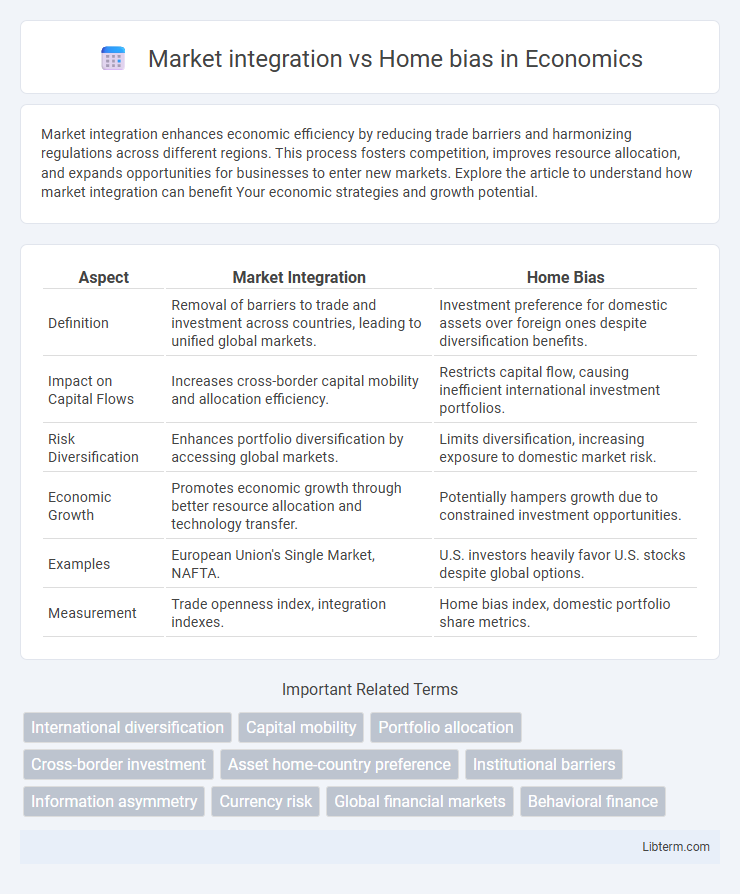Market integration enhances economic efficiency by reducing trade barriers and harmonizing regulations across different regions. This process fosters competition, improves resource allocation, and expands opportunities for businesses to enter new markets. Explore the article to understand how market integration can benefit Your economic strategies and growth potential.
Table of Comparison
| Aspect | Market Integration | Home Bias |
|---|---|---|
| Definition | Removal of barriers to trade and investment across countries, leading to unified global markets. | Investment preference for domestic assets over foreign ones despite diversification benefits. |
| Impact on Capital Flows | Increases cross-border capital mobility and allocation efficiency. | Restricts capital flow, causing inefficient international investment portfolios. |
| Risk Diversification | Enhances portfolio diversification by accessing global markets. | Limits diversification, increasing exposure to domestic market risk. |
| Economic Growth | Promotes economic growth through better resource allocation and technology transfer. | Potentially hampers growth due to constrained investment opportunities. |
| Examples | European Union's Single Market, NAFTA. | U.S. investors heavily favor U.S. stocks despite global options. |
| Measurement | Trade openness index, integration indexes. | Home bias index, domestic portfolio share metrics. |
Understanding Market Integration: A Brief Overview
Market integration reflects the extent to which different financial markets operate as a single unified market, enabling seamless cross-border capital flows and price equalization. High market integration reduces investment barriers and aligns asset returns across countries, contrasting sharply with home bias, where investors disproportionately favor domestic assets despite potential gains from diversification. Understanding market integration involves analyzing liquidity, regulatory harmonization, and information flow that facilitate global portfolio diversification and risk sharing.
Defining Home Bias in Investment Portfolios
Home bias in investment portfolios refers to the tendency of investors to allocate a disproportionately large share of their assets to domestic equities despite the advantages of diversification through international investments. This preference often results from factors such as familiarity, perceived lower risk, and information asymmetry about foreign markets. Market integration challenges home bias by enabling easier access to global financial markets, encouraging portfolio diversification that can reduce overall investment risk.
Key Drivers of Market Integration
Market integration is driven primarily by regulatory harmonization, technological advancements, and increased cross-border capital flows, enabling seamless transactions and reduced market segmentation. Home bias persists due to information asymmetry, currency risk, and investor familiarity with domestic markets, which limit international portfolio diversification. Financial market liberalization and improved communication infrastructures further erode home bias by facilitating access to foreign investment opportunities.
Factors Contributing to Persistent Home Bias
Persistent home bias in investment portfolios arises from factors such as information asymmetry, where domestic investors have better access to local market data and corporate governance practices. Transaction costs and regulatory barriers increase the expense and complexity of investing abroad, discouraging international diversification. Behavioral factors including familiarity preference and perceived political or currency risks further reinforce the tendency to favor domestic assets despite the benefits of global market integration.
Economic Impacts of Market Integration
Market integration reduces home bias by facilitating cross-border capital flows and risk diversification, leading to more efficient allocation of resources and higher economic growth. Enhanced financial connectivity lowers transaction costs and volatility, stimulating investment and productivity across integrated economies. This integration promotes convergence in economic performance and reduces the adverse effects of market segmentation on global wealth distribution.
Risks and Limitations of Home Bias
Home bias exposes investors to concentrated country-specific risks such as economic downturns, political instability, and currency fluctuations, limiting diversification benefits. This localized exposure reduces portfolio resilience against global market shocks and may lead to suboptimal risk-adjusted returns. Consequently, investors with significant home bias face challenges in achieving efficient market integration and optimizing risk management.
Market Integration vs. Home Bias: Comparative Analysis
Market integration reduces home bias by enabling investors to diversify internationally, leading to better risk-sharing and increased capital flows across borders. Empirical studies show that countries with higher market integration exhibit lower home bias, as barriers to cross-border investments decline due to improved information transparency and reduced transaction costs. Comparative analysis reveals that institutional quality, financial development, and cultural proximity significantly influence the extent of home bias despite market integration efforts.
Influences of Behavioral Finance on Home Bias
Behavioral finance concepts such as overconfidence, familiarity bias, and loss aversion significantly contribute to home bias by causing investors to prefer domestic assets over foreign ones despite potential diversification benefits. Market integration can mitigate home bias by providing better information flow and reducing perceived risks associated with foreign investments, but psychological factors often sustain investor preference for local markets. Empirical studies show that addressing behavioral biases through investor education and transparent global market access may promote more balanced international portfolio allocations.
Policy Implications for Reducing Home Bias
Policies encouraging international portfolio diversification can reduce home bias by lowering informational barriers and transaction costs for foreign investments. Regulatory reforms promoting transparency and harmonization of cross-border financial regulations enhance market integration and investor confidence. Tax incentives for foreign asset holdings and development of global financial infrastructure also play critical roles in diminishing home bias and fostering efficient capital allocation.
Future Trends: Toward Greater Market Integration
Future trends indicate a significant reduction in home bias as investors increasingly seek global diversification, facilitated by advancements in technology and regulatory harmonization. Enhanced cross-border capital flows and the rise of integrated financial markets are driving greater market integration, creating opportunities for improved risk sharing and portfolio optimization. Emerging markets are expected to play a pivotal role, contributing to the broadening scope of global investment and reducing traditional domestic preference in asset allocation.
Market integration Infographic

 libterm.com
libterm.com